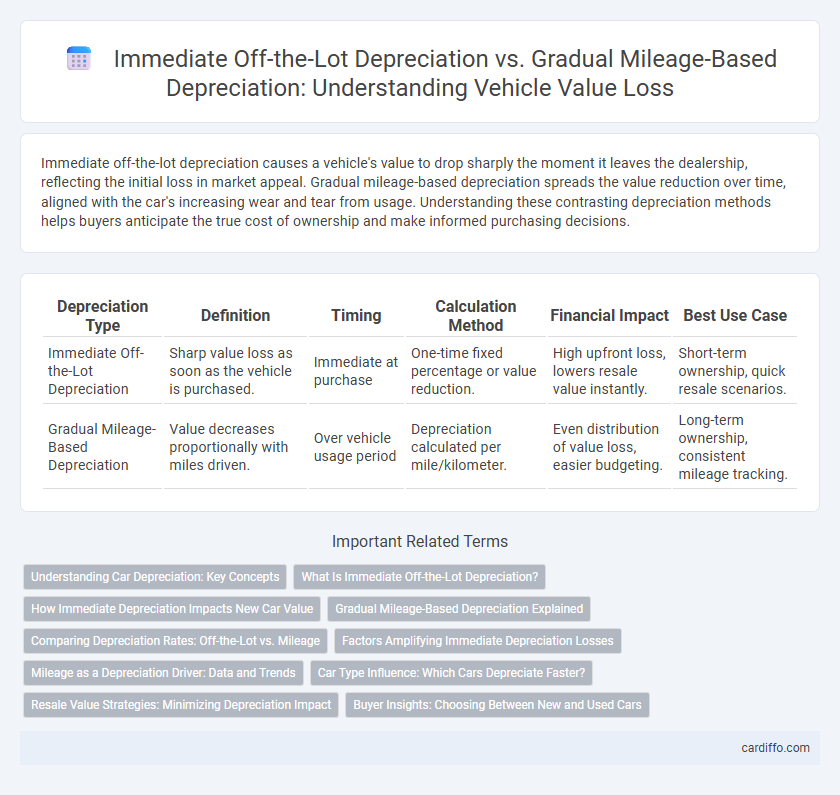Immediate off-the-lot depreciation causes a vehicle's value to drop sharply the moment it leaves the dealership, reflecting the initial loss in market appeal. Gradual mileage-based depreciation spreads the value reduction over time, aligned with the car's increasing wear and tear from usage. Understanding these contrasting depreciation methods helps buyers anticipate the true cost of ownership and make informed purchasing decisions.
Table of Comparison
| Depreciation Type | Definition | Timing | Calculation Method | Financial Impact | Best Use Case |
|---|---|---|---|---|---|
| Immediate Off-the-Lot Depreciation | Sharp value loss as soon as the vehicle is purchased. | Immediate at purchase | One-time fixed percentage or value reduction. | High upfront loss, lowers resale value instantly. | Short-term ownership, quick resale scenarios. |
| Gradual Mileage-Based Depreciation | Value decreases proportionally with miles driven. | Over vehicle usage period | Depreciation calculated per mile/kilometer. | Even distribution of value loss, easier budgeting. | Long-term ownership, consistent mileage tracking. |
Understanding Car Depreciation: Key Concepts
Immediate off-the-lot depreciation causes a vehicle to lose up to 20-30% of its value the moment it is purchased, reflecting its transition from new to used status. Gradual mileage-based depreciation steadily decreases a car's value over time, typically at an average rate of 15-25% per year depending on usage and maintenance. Understanding these key depreciation concepts helps buyers anticipate value loss and make informed decisions on car purchases and resale timing.
What Is Immediate Off-the-Lot Depreciation?
Immediate off-the-lot depreciation refers to the sharp decline in a vehicle's value that occurs as soon as it is driven off the dealership lot, often amounting to 20-30% of the car's original price. This type of depreciation is primarily influenced by the transition from a "new" to a "used" status, affecting market perception and resale value instantly. It contrasts with gradual mileage-based depreciation, which reduces a car's value more slowly over time based on accumulated miles and wear.
How Immediate Depreciation Impacts New Car Value
Immediate off-the-lot depreciation causes new cars to lose approximately 20-30% of their value the moment they are driven off the dealership, significantly impacting resale prices. This sharp decline contrasts with gradual mileage-based depreciation, which reduces vehicle value incrementally over time depending on usage. Understanding immediate depreciation is crucial for buyers looking to minimize financial loss on new car investments.
Gradual Mileage-Based Depreciation Explained
Gradual mileage-based depreciation calculates a vehicle's value loss based on the number of miles driven, with higher mileage correlating to greater depreciation. This method reflects real usage and wear, making it a precise indicator of a car's market value over time. Typically, vehicles lose approximately 15-25 cents in value per mile driven, offering a more predictable depreciation pattern compared to immediate off-the-lot depreciation.
Comparing Depreciation Rates: Off-the-Lot vs. Mileage
Immediate off-the-lot depreciation typically causes a new vehicle to lose 20% to 30% of its value the moment it is driven off the dealership, representing a steep initial value drop within the first few days. In contrast, gradual mileage-based depreciation averages about 15% to 25% annually, depending on the vehicle type, usage, and maintenance, reflecting a slower, more consistent decline tied directly to the odometer reading. Comparing these rates highlights that the initial purchase and delivery phase holds the most significant value loss, while subsequent depreciation depends heavily on mileage accumulation and wear.
Factors Amplifying Immediate Depreciation Losses
Immediate off-the-lot depreciation loss is amplified by factors such as the vehicle's make, model popularity, and market demand fluctuations, which cause a sharp initial value drop upon purchase. High initial depreciation rates often result from technological obsolescence, higher purchase prices, and the sale of new cars at dealer discounts. In contrast, gradual mileage-based depreciation depends on usage patterns and maintenance, making these immediate market-driven factors critical in amplifying initial loss intensity.
Mileage as a Depreciation Driver: Data and Trends
Mileage significantly influences vehicle depreciation, with studies showing cars lose approximately 20% of their value within the first year due to immediate off-the-lot depreciation and an additional 10-15% per 10,000 miles driven. Market data indicates that high-mileage vehicles depreciate faster than low-mileage counterparts, emphasizing the importance of mileage as a key factor in residual value assessments. Trends reveal that consumers and insurers increasingly rely on mileage metrics to estimate depreciation, reflecting its critical role in pricing used vehicles accurately.
Car Type Influence: Which Cars Depreciate Faster?
Luxury cars and electric vehicles tend to experience immediate off-the-lot depreciation at a faster rate due to high initial retail prices and rapid technological advancements. In contrast, economy and hybrid cars generally undergo gradual mileage-based depreciation, maintaining value longer as their market demand remains steadier. SUVs and trucks often balance between these patterns, with depreciation rates influenced by brand reputation and usage intensity.
Resale Value Strategies: Minimizing Depreciation Impact
Immediate off-the-lot depreciation causes vehicles to lose a significant portion of their value the moment they are purchased, making early resale less financially advantageous. Gradual mileage-based depreciation allows owners to better manage resale value by aligning vehicle condition with usage, preserving worth over time through controlled mileage accumulation. Effective resale value strategies prioritize minimizing immediate depreciation losses by buying slightly used cars and maintaining low mileage to enhance overall asset retention.
Buyer Insights: Choosing Between New and Used Cars
Immediate off-the-lot depreciation causes new cars to lose value rapidly within the first year, often up to 20-30%, making used cars a more cost-effective option for budget-conscious buyers. Gradual mileage-based depreciation in used cars results in a slower decline in value, allowing buyers to better predict long-term ownership costs based on expected usage. Understanding these depreciation patterns helps buyers make informed decisions by balancing initial purchase price against potential resale value.
Immediate Off-the-Lot Depreciation vs Gradual Mileage-Based Depreciation Infographic

 cardiffo.com
cardiffo.com